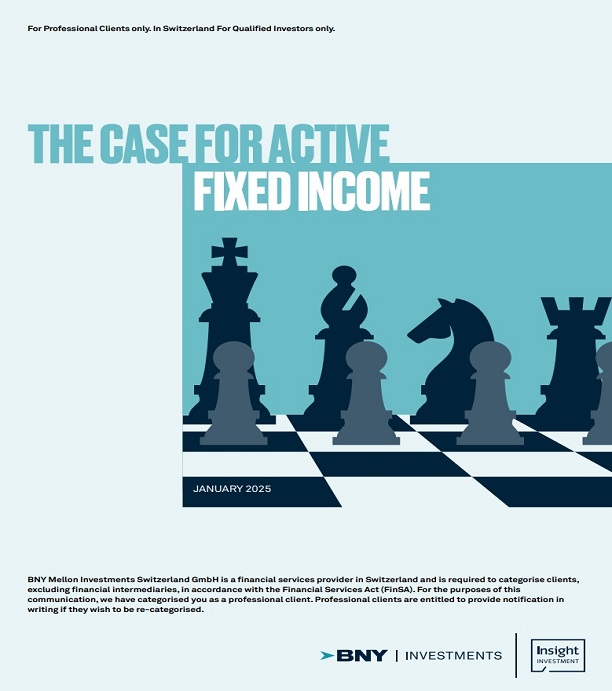7 moves active managers can make to enhance fixed income returns
Like grandmasters in chess, active managers must think strategically when it comes to the moves they make on the board of fixed income. Here, we detail the seven moves active managers can utilise to stay ahead of the game…
Investment into fixed income is growing. In 2024, total fixed income issuance increased by 25.6% when compared year on year1. At the same time, across some major segments of fixed income markets, both returns and volatility have diverged away from expectations over the 12 months to the end of December 2024. So, just like grandmasters in chess, active managers in fixed income need to think several moves ahead and balance strategy with tactics.

Here, we detail seven moves that active investors can utilise to stay ahead of the game…
Choosing your move | The right selection | Capturing the piece | Complex moves | Check-mate
Choosing your move

Duration and yield curve strategies
Active managers can strategically position their portfolios based on their outlook for market yields. If they anticipate a decline in yields, they might add longer-maturity issues, which are expected to benefit the most from such a scenario. More sophisticated strategies may involve targeting specific segments of the yield curve or varying investments across different maturities. For instance, if credit spreads are relatively uniform across maturities, a manager might overweight credit exposure in shorter maturities while favouring government bonds in longer maturities. This enhances portfolio yield while minimising the impact of any future widening of spreads.
Beta management
The constituents of a bond index represent a certain level of aggregate credit risk at any given time. Active managers have the flexibility to take on higher or lower credit risk compared to the index. This decision can be influenced by the stage of the credit cycle, average valuations, or a tactical market view. A prime example is the Bloomberg Aggregate Index, which includes both government and corporate bonds. Active managers can adjust their credit exposure by overweighting or underweighting these asset classes based on their relative attractiveness.
The right selection

Security selection via fundamental analysis
Fundamental credit analysis aims to identify securities whose valuations do not accurately reflect the company’s current and future fundamental strength or weakness. When selecting an issuer’s securities, it is crucial to choose those with robust balance sheets and easy access to money markets. Additionally, issuers may need to be stress tested for risks such as litigation, new regulations, environmental or social factors, and potential mergers or acquisitions.
Sector strategy
Whole industry sectors in fixed income markets can sometimes have valuations that do not reflect the current or future strength or weakness of their constituent companies. This is often due to the sector experiencing a slightly differentiated economic cycle than the broader market. Additionally, some industry sectors may become overleveraged relative to others, making them less attractive to active managers. Importantly, active managers have the flexibility to avoid investing in sectors where they believe the outlook is concerning.
Capturing the piece

Capturing new-issue premia
Unlike equities, fixed income investments generally have a fixed maturity date. As they approach this date, the issuing sovereign or company often needs to return to the market to refinance the debt. They may also issue new debt for various reasons, such as funding growth or acquisitions. In the corporate world, issuers often offer new debt at slightly higher yields than the market to attract buyers – a phenomenon known as new issue premia. Active managers can capitalise on this by keeping a close eye on opportunities in primary issuance markets.
Complex moves

Exploiting market fragmentation
When an investor buys an equity, the process is typically straightforward, with a single class of share to purchase. However, when an investor buys a bond, a single corporate issuer may have a range of debt issues across different maturities and currencies, each with different legal documentation, and even exposed to different parts of the capital structure. Each issue may be a different size, with variable levels of liquidity. This fragmentation introduces a range of options for an active manager to consider. For example, an investor might decide to target a higher yield by purchasing the lower-rated subordinated debt of a large corporate issuer. Although the risks are higher in the event of a default than if the investor bought a higher-rated issue, the investor may judge that the substantial size and strong market position of the corporation significantly mitigates this risk.
Check-mate

Relative value
The value of fixed income instruments can fluctuate across markets or between segments of the fixed income universe at any given time. For instance, a large US company may issue bonds in US dollars, Japanese yen and euros, with the spread varying depending on the currency of issue. Active managers can capitalise on these variations by overweighting the credit in the market that offers the greatest value and underweighting the credit in the market that offers the least value. Notably, these strategies can be used not just to outperform a specific benchmark or index. They can also be used by active fixed income managers seeking to generate an absolute, positive return through different market conditions.
For more information on fixed income, visit our capabilities page:

Read the paper - The case for active fixed income

The value of investments can fall. Investors may not get back the amount invested. Income from investments may vary and is not guaranteed.
1 Capital Markets Fact Book2024 increased between 2023 and 2024 year on year, sourced by SIFMA research, accessed 27/2/25
2338059 Exp : 28 February 2026
YOU MIGHT ALSO LIKE
We asked experts across three of our investment firms about the key themes that could be shaping the economy in the second half of 2025 and how they believe their asset classes may fare.
Absolute return bond strategies are designed to deliver a positive return in all environments. In an era characterised by high volatility, Insight Investment portfolio managers Harvey Bradley and Shaun Casey explain why they think absolute return strategies can be used by those seeking a mixture of stable growth and capital preservation.
Many obituaries have been written for the 60/40 model, yet it has had surprising resilience as the default equity/bond setting for a balanced investor.
Insight Investment’s head of global credit, Adam Whiteley shares his views on why he believes the time for active global credit is now.








